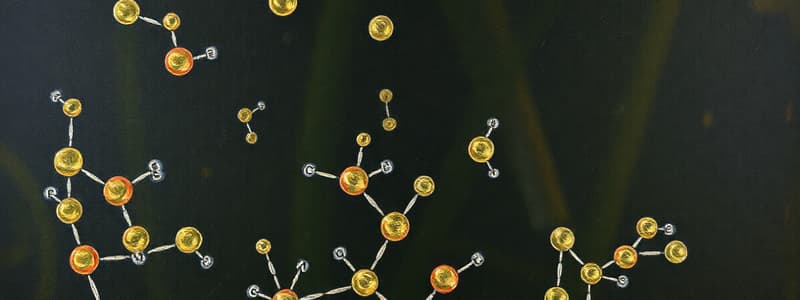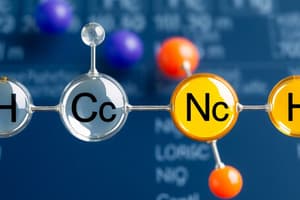Podcast
Questions and Answers
Which statement accurately describes a key property of covalent compounds?
Which statement accurately describes a key property of covalent compounds?
- They typically form strong crystal lattices.
- They exhibit high electrical conductivity in aqueous solutions.
- They are formed through the transfer of electrons between atoms.
- They generally have low melting points due to weak intermolecular forces. (correct)
What is the correct chemical formula for dinitrogen pentoxide?
What is the correct chemical formula for dinitrogen pentoxide?
- N$_2$O$_3$
- N$_5$O$_2$
- N$_2$O$_5$ (correct)
- NO$_5$
Which of the following compounds is incorrectly named?
Which of the following compounds is incorrectly named?
- N$_2$O$_4$: Dinitrogen tetroxide
- CO: Carbon monoxide
- OF$_2$: Oxygen difluoride (correct)
- PCl$_5$: Phosphorus pentachloride
What is the correct name for the covalent compound CCl$_4$?
What is the correct name for the covalent compound CCl$_4$?
Select the correct chemical formula for silicon tetrabromide.
Select the correct chemical formula for silicon tetrabromide.
Which of the following compounds does NOT require prefixes when naming it?
Which of the following compounds does NOT require prefixes when naming it?
What is the chemical formula for carbon tetrahydride?
What is the chemical formula for carbon tetrahydride?
Identify the compound that is incorrectly matched with its properties.
Identify the compound that is incorrectly matched with its properties.
What is the correct name for the compound N$_2$O$_3$?
What is the correct name for the compound N$_2$O$_3$?
Which of the following is true: when naming covalent compounds, the prefix 'mono'...
Which of the following is true: when naming covalent compounds, the prefix 'mono'...
Flashcards
Melting point of covalent compounds
Melting point of covalent compounds
Covalent compounds have weaker intermolecular forces.
Electrical conductivity of covalent compounds
Electrical conductivity of covalent compounds
Covalent compounds do not conduct electricity because they don't form ions.
Mono
Mono
A prefix used to indicate one atom of an element in a molecular compound.
Di
Di
Signup and view all the flashcards
Tri
Tri
Signup and view all the flashcards
Tetra
Tetra
Signup and view all the flashcards
Penta
Penta
Signup and view all the flashcards
Hexa
Hexa
Signup and view all the flashcards
Prefix 'mono'
Prefix 'mono'
Signup and view all the flashcards
Study Notes
- Covalent compounds have lower melting points because the forces between molecules are weak.
- Covalent compounds do not conduct electricity because they are not made of ions.
- Examples of covalent compounds are hydrogen chloride (HCl), methane (CH4), ammonia (NH3), carbon dioxide (CO2), proteins, and carbohydrates (sugars and starch).
Naming Molecular Compounds
- Prefixes indicate the number of atoms in each compound.
- The prefix "mono" is not used on the first element, only if there is one of the second element.
Prefixes and Corresponding Number of Atoms
- Mono- represents 1 atom, example Carbon Monoxide (CO)
- Di- represents 2 atoms, example Carbon Dioxide (CO2)
- Tri- represents 3 atoms, example Sulfur Trioxide (SO3)
- Tetra- represents 4 atoms, example Carbon Tetrafluoride (CF4)
- Penta- represents 5 atoms, example Phosphorus Pentabromide (PBr5)
- Hexa- represents 6 atoms
- Hepta- represents 7 atoms
- Octo- represents 8 atoms
- Nona- represents 9 atoms
- Deca- represents 10 atoms
Prefix Exceptions
- The prefix "mono" is omitted from the first element in the compound.
- CO is called carbon monoxide, not monocarbon monoxide.
Examples of Naming Molecular Compounds
- CO is carbon monoxide.
- CO2 is carbon dioxide.
- NH3 is ammonia.
- H2O is water.
- OCl2 is oxygen dichloride.
- CCl4 is carbon tetrachloride.
- PCl5 is phosphorus pentachloride.
- C3H8 is tricarbon octahydride.
Examples of Molecular Compound Formulas
- Nitrogen monoxide is NO.
- Carbon tetrahydride is CH4.
- Nitrogen pentoxide is N2O5.
- Silicon tetrabromide is SiBr4.
- Boron trihydride is BH3.
Studying That Suits You
Use AI to generate personalized quizzes and flashcards to suit your learning preferences.



